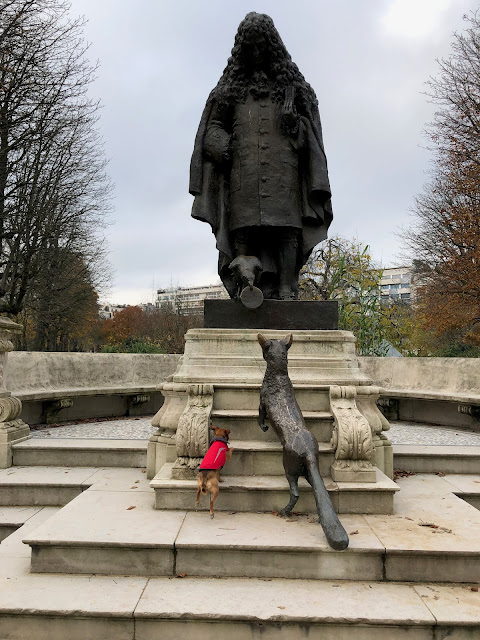It's not entirely easy having a dog in Paris. On one hand, dogs seem to be everywhere. You can pretty much take them into most stores and even some restaurants allow dogs inside. On the other hand, very few neighborhood parks permit dogs. It's hard to say I blame the city for this. Parisiens are notorious for not picking up after their dogs. At least the parks offer some outdoor space where you don't have to be on your guard constantly against stepping in dog shit.
One of the dog-friendly exceptions in the 16th Arr. is the 15-acre Jardin du Ranelagh. Modeled after the Earl of Ranelagh's London gardens, le jardin welcomes dogs (and others) to stroll the footpaths surrounding its lawns, landscaping and playgrounds. Better still, it has a large, fenced-in, off-leash area along the Petite Ceinture (part of a reclaimed railway path that ran along the outskirts of Paris until the mid-20th century).
Like most neighborhood parks in Paris, le jardin is also home to great public art. One of my favorites in the entire city is Charles Correia's 1984 monument to Jean de la Fontaine. La Fontaine was a 17th century poet and author, remembered today principally as a translator of Æsop's Fables into the French. The statue depicts La Fontaine with the crow and the fox from the fable of the same name ("le corbeau et le renard"). Apparently, in Æsop's telling, a hungry fox came across a crow with a wheel of cheese. Rather than eat both the crow and the cheese, the fox instead starts laying on some pretty thick smooth talk. Overjoyed at this flattery, the squawking crow drops the cheese into the jaws of the waiting fox. There must be a moral there, but I'm not sure what it is.
 |
| Monsieur La Fontaine, weaving a tale of treachery. |
 |
| Sugar puts herself in position to recover the fumbled fromage. |
 |
| A hungry fox, not a werewolf. |
As if cheese theft in France wasn't bad enough, other sculptures in le jardin commemorate classical instances of more serious crimes such as fratricide (Cain, 1871, by Joseph-Michel Caillé) and murder-dismemberment (Pêcheur ramenant dans ses filets la tête d'Orphée, 1882, by Léon-Eugène Longepied). There are also puppet shows.
 |
| A fisherman hauls in Orpheus' lyre and decapitated head |







Comments
Post a Comment